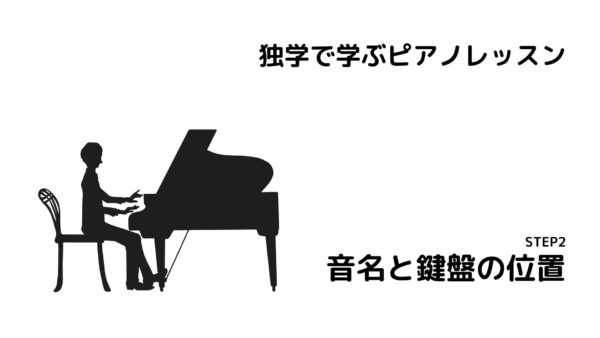
独学でピアノを学ぶ大人の初心者のための学習講座です。
ステップ2は「音名と指番号」を覚えていきましょう。
ここまで覚えたら実際に演奏です。
頭で覚えることも多いですが、どれもとても大事な要素です。
「音名」や「鍵盤の位置」は、小さい頃の音楽の時間に鍵盤ハーモニカやオルガンで勉強した人も多いでしょう。
その時の記憶がある方は読み飛ばして問題ありません。
どんなのだったか忘れた方はもう一度しっかり勉強していきましょう。
では詳しく解説していきます。
所要時間は「約15分」です。
今回のテーマ
- 「音名」
- 「鍵盤の位置」
- 「指番号」
- 「実際に弾いてみよう」
音名
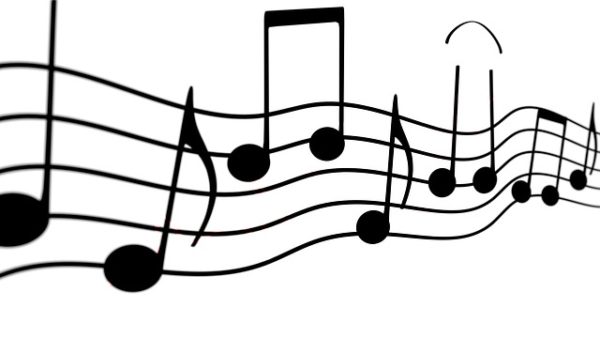
最初は「音名」についてです。
「ド レ ミ ファ ソ ラ シ」
の名前が音名になります。
「ド」から始まった音が高い音になっていくと「レ ミ ファ・・・」と続いていきます。
「シ」の後は再び「ド」になり、これを繰り返していきます。
「ファの次は何?」と聞かれて、少し考えるようではこの後の学習が非常に時間がかかってしまいます。
この順番をしっかりと頭に残しておいてください。
例えていうなら算数の九九のようなものです。
しっかりと順番を記憶し、効率よくピアノの練習ができるようにしておきましょう。
本当は厳密に「音名」や「音階」、「階名」などという言葉を説明していくと、難しく長ーい説明になってしまいます。
最初はこれらを覚える必要はありませんので、音名だけ覚えておきましょう。
鍵盤の位置
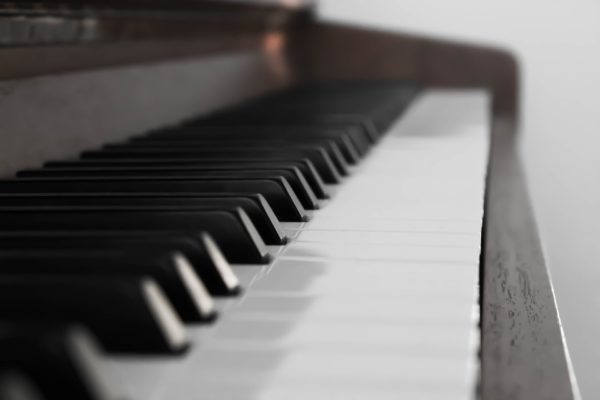
先ほどまでの「音名」がピアノではどの鍵盤に当てはまるのかを知る必要がありますね。
次は鍵盤の位置について学習していきます。
まずは鍵盤を見てみましょう。
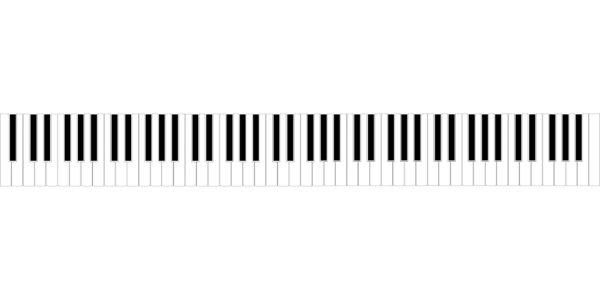
この中で黒い鍵盤である黒鍵を見ていくと、「2つ並び・3つ並び・2つ並び」と規則的に並んでいるのがわかります。
ピアノで音名を考えるときは、この並びを利用して次の図ような区画に分けます。
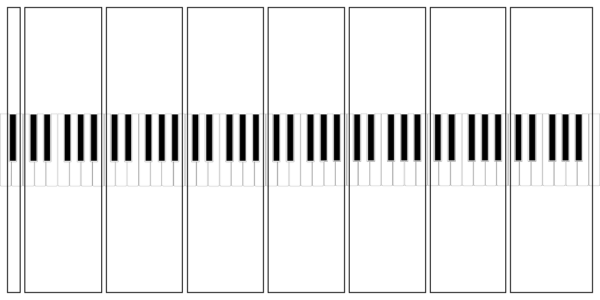
つまり、黒鍵5個分と白鍵7つが1つの区画になるわけです。
このように鍵盤を分けることで、それぞれの鍵盤に対応する音名がわかりやすくなるのです。
ちなみにこの1つの区画を「オクターブ」と呼びます。
この1つのオクターブのなかを拡大して音名を入れていくと下図のようになります。

一番左側が「ド」になり、そこから「レ ミ ファ・・・」となっていくわけです。
記載はしていませんが、右のオクターブも左のオクターブも同じように「ドレミファソラシ」の音名がついていきます。
これですべての音名がわかりますね。
この鍵盤の位置をしっかり覚えておくことで、楽譜を見て練習する際にスムーズに演奏できる等になります。
指番号
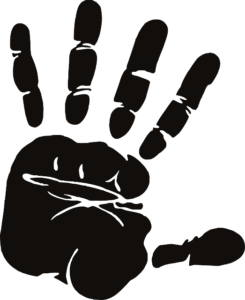
次に指番号です。
指番号とはその名の通り、それぞれの指に番号を割り当てたものです。

図で表しているように
・親指:1
・人差し指:2
・中指:3
・薬指:4
・小指:5
となります。
このとき右手と左手の区別はなく、どちらも同じ番号を使います。
そのため、どっちの手の番号かはそのときの状況を見て判断しなければなりません。
指番号は、特に初心者向けの楽譜の中で、音符の下に記載していることがあります。
その場合は、その音を「指番号の指で弾く」という意味で使われます。
楽譜の読み方についてはステップ4で詳しく学習しますが、ここでは番号とそれに対応する指を覚えておきましょう。
ちなみに指番号はピアノだけではなく、様々な楽器で使用されています。
もしピアノ以外の楽器をやったことがある方で指番号を知っている方は、同じように考えて問題ないでしょう。
実際に練習してみよう
さてここまで、「音名」「鍵盤の位置」「指番号」を学習してきました。
それらを使って次の練習問題を演奏してみましょう。
難しいテクニックは使わない、簡単な音の並びで作成しています。
右手と左手で別々に練習していきますが、最初はどちらの手も小指で演奏する音が小さくなりがちです。
音の大きさが指によって極端に違う場合は姿勢や力のかけ方が間違っている可能性があります。
ステップ1に戻ってもう一度学習してみてください。
また、大きさだけでなくそれぞれの音をスムーズに演奏するように心がけてください。
できない場合は何度も繰り返し練習しましょう。
右手練習①
最初に右手の練習です。
右手の親指を鍵盤の「ド」の位置に置いてください。
その後次の音名に対応したピアノの鍵盤を、各指番号で演奏してください。
練習は左から順番に演奏していきます。

右手練習②
次は「ラ」の音まで演奏します。
①と同じく右手の親指を鍵盤の「ド」の位置に置いてください。
演奏するのは「きらきら星」の最初のフレーズです。
できるだけ「ソ」と「ラ」の間で止まらないように、手をスライドさせながらリズムよく演奏しましょう。

右手練習③
最後の右手練習です。
演奏するのは童謡「カエルの合唱」です。
今までよりも長い演奏になりますので、途中で区切りながら少しずつ進んでいきましょう。
また、今回は「連続する同じ音名の鍵盤」を「少しずつ違う指」で演奏していきます。
指番号に注意してください。
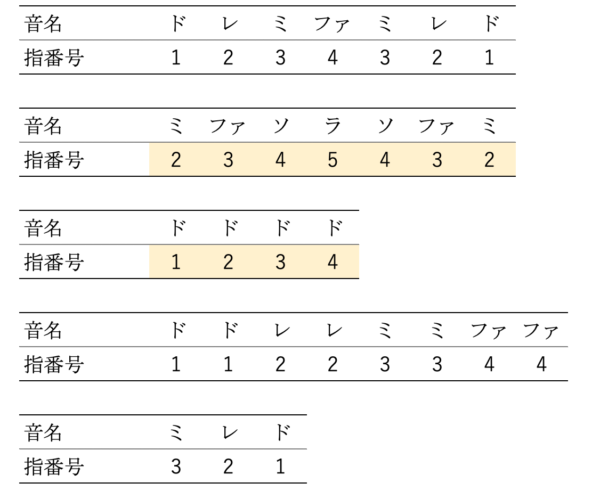
左手練習①
つぎに左手の練習になります。
演奏する内容は右手練習とおなじですが、指番号が反対になります。
多くの方が右利きなため、最初は左手がうまく演奏できない方が多いです。
誰もが苦労することですので、焦らず、右手よりもじっくり時間をかけて練習していきましょう。
左手の小指を鍵盤の「ド」の位置に置いてください。(親指は「ソ」)
その後次の音名に対応したピアノの鍵盤を、各指番号で演奏してください。
練習は左から順番に演奏していきます。

左手練習②
内容は右手練習と同じです。
右手に比べて左手は親指が右側にくるため、この練習②では左手の方が演奏しやすいかも知れません。

左手練習③
最後に「カエルの合唱」です。
特に指番号:5、小指で弾く音には、大きさやリズムに注意しながら演奏しましょう。

最後までスムーズに演奏することができればこのレッスンは終了です。
右手と左手の演奏が同じようにできるには、まだまだ練習が必要になります。
演奏できるまでに時間がかかった手は、この後のレッスンでも重点的に時間をかけて練習していきましょう。
このレッスンのまとめ
- 「音名」
- ・ド , レ , ミ , ファ , ソ , ラ , シ の名前が音名
- ・シのあとは再びドになる
- 「鍵盤の位置」
- ・鍵盤はそれぞれの区画で分けられる
- ・1つの区画を「オクターブ」と呼ぶ
- ・1つのオクターブの中の白い鍵盤が順番に「ド , レ , ミ , ファ , ソ , ラ , シ 」になる
- 「指番号」
- ・親指:1、人差し指:2、中指:3、薬指:4、小指:5
- ・右手と左手どちらの指も同じように番号がつけられる
- ・楽譜に番号が書いてあれば、その番号の指で演奏する
金次郎長伝 says
70歳の手習いですが、頑張ります。